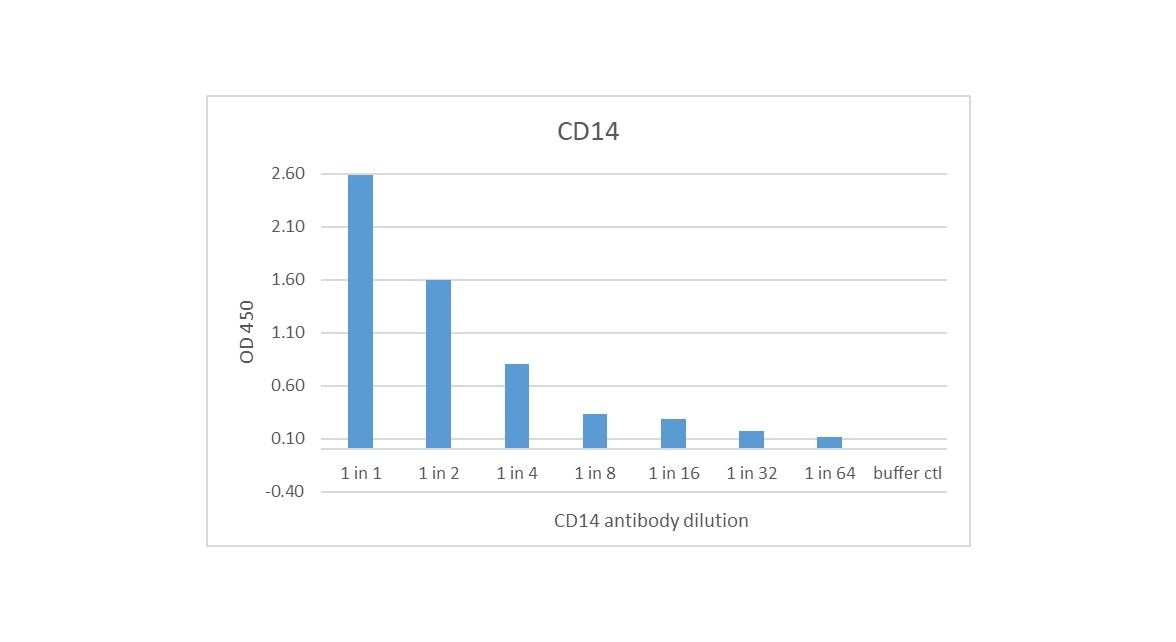Recombinant Mouse CD14 Fc Chimera Protein, CF Summary
Product Specifications
| Mouse CD14 (Ala18-Pro345) Accession # Q4FJP7 |
IEGRMD | Human IgG1 (Pro100-Lys330) |
| N-terminus | C-terminus | |
Analysis
Product Datasheets
Carrier Free
CF stands for Carrier Free (CF). We typically add Bovine Serum Albumin (BSA) as a carrier protein to our recombinant proteins. Adding a carrier protein enhances protein stability, increases shelf-life, and allows the recombinant protein to be stored at a more dilute concentration. The carrier free version does not contain BSA.
In general, we advise purchasing the recombinant protein with BSA for use in cell or tissue culture, or as an ELISA standard. In contrast, the carrier free protein is recommended for applications, in which the presence of BSA could interfere.
982-CD
| Formulation | Lyophilized from a 0.2 μm filtered solution in PBS. |
| Reconstitution | Reconstitute at 1 mg/mL in sterile PBS. |
| Shipping | The product is shipped at ambient temperature. Upon receipt, store it immediately at the temperature recommended below. |
| Stability & Storage: | Use a manual defrost freezer and avoid repeated freeze-thaw cycles.
|
Reconstitution Calculator
Background: CD14
CD14 is a 55 kDa cell surface glycoprotein that is preferentially expressed on monocytes/macrophages. The mouse CD14 cDNA encodes a 366 amino acid (aa) residue precursor protein with a 15 aa signal peptide and a C-terminal hydrophobic region characteristic for glycosylphosphatidyinositol (GPI)-anchored proteins. Mouse CD14 has five potential N-linked glycosylation sites and also bears O-linked carbohydrates. The amino acid sequence of mouse CD14 is approximately 65% and 82% identical to the human and rat proteins, respectively. CD14 is a pattern recognition receptor that binds lipopolysaccharides (LPS) and a variety of ligands derived from different microbial sources. The binding of CD14 with LPS is catalyzed by LPS-binding protein (LBP). The toll-like-receptors have also been implicated in the transduction of CD14-LPS signals. Similar to other GPI-anchored proteins, soluble CD14 can be released from the cell surface by phosphatidyinositol-specific phospholipase C. Soluble CD14 has been detected in serum and body fluids. High concentrations of soluble CD14 have been shown to inhibit LPS-mediated responses. However, soluble CD14 can also potentiate LPS response in cells that do not express cell surface CD14.
- Wright, S.D. et al. (1990) Science 249:1431.
- Pugin, J. et al. (1993) Proc. Natl. Acad. Sci. USA 90:2744.
- Beutler, B. (2000) Current Opinion in Immunology 12:20.
- Stelter, F. (2000) Chem. Immunol. 74:25.
Citations for Recombinant Mouse CD14 Fc Chimera Protein, CF
R&D Systems personnel manually curate a database that contains references using R&D Systems products. The data collected includes not only links to publications in PubMed, but also provides information about sample types, species, and experimental conditions.
6
Citations: Showing 1 - 6
Filter your results:
Filter by:
-
Endothelial E-selectin inhibition improves acute myeloid leukaemia therapy by disrupting vascular niche-mediated chemoresistance
Authors: V Barbier, J Erbani, C Fiveash, JM Davies, J Tay, MR Tallack, J Lowe, JL Magnani, DR Pattabiram, AC Perkins, J Lisle, JEJ Rasko, JP Levesque, IG Winkler
Nat Commun, 2020-04-27;11(1):2042.
Species: Mouse
Sample Types: Whole Cells
Applications: Bioassay -
Funiculosin variants and phosphorylated derivatives promote innate immune responses via the Toll-like receptor 4/myeloid differentiation factor-2 complex
Authors: N Okamoto, K Mizote, H Honda, A Saeki, Y Watanabe, T Yamaguchi-, R Fukui, N Tanimura, Y Motoi, S Akashi-Tak, T Kato, S Fujishita, T Kimura, U Ohto, T Shimizu, T Hirokawa, K Miyake, K Fukase, Y Fujimoto, Y Nagai, K Takatsu
J. Biol. Chem., 2017-07-28;0(0):.
Species: Mouse
Sample Types: Whole Cells
Applications: Bioassay -
CD36 Differently Regulates Macrophage Responses to Smooth and Rough Lipopolysaccharide
Authors: R Biedro?, A Peru?, S Józefowski
PLoS ONE, 2016-04-13;11(4):e0153558.
Species: Mouse
Sample Types: Recombinant Protein
Applications: Enzyme Assay -
Functional analysis of recombinant calreticulin fragment 39-272: implications for immunobiological activities of calreticulin in health and disease.
Authors: Hong C, Qiu X, Li Y
J. Immunol., 2010-09-20;185(8):4561-9.
Species: Mouse
Sample Types:
Applications: ELISA Developmet -
CD14 is an essential mediator of LPS-induced airway disease.
Authors: Brass DM, Hollingsworth JW, McElvania-TeKippe E, Garantziotis S, Hossain I, Schwartz DA
Am. J. Physiol. Lung Cell Mol. Physiol., 2007-03-23;293(1):L77-83.
Species: Mouse
Sample Types: In Vivo
Applications: In Vivo -
Prostaglandin D2 mediates neuronal damage by amyloid-beta or prions which activates microglial cells.
Authors: Bate C, Kempster S, Williams A
Neuropharmacology, 2005-11-11;50(2):229-37.
Species: Mouse
Sample Types: Whole Cells
Applications: Binding Assay
FAQs
No product specific FAQs exist for this product, however you may
View all Proteins and Enzyme FAQsReviews for Recombinant Mouse CD14 Fc Chimera Protein, CF
Average Rating: 4 (Based on 1 Review)
Have you used Recombinant Mouse CD14 Fc Chimera Protein, CF?
Submit a review and receive an Amazon gift card.
$25/€18/£15/$25CAN/¥75 Yuan/¥2500 Yen for a review with an image
$10/€7/£6/$10 CAD/¥70 Yuan/¥1110 Yen for a review without an image
Filter by:







